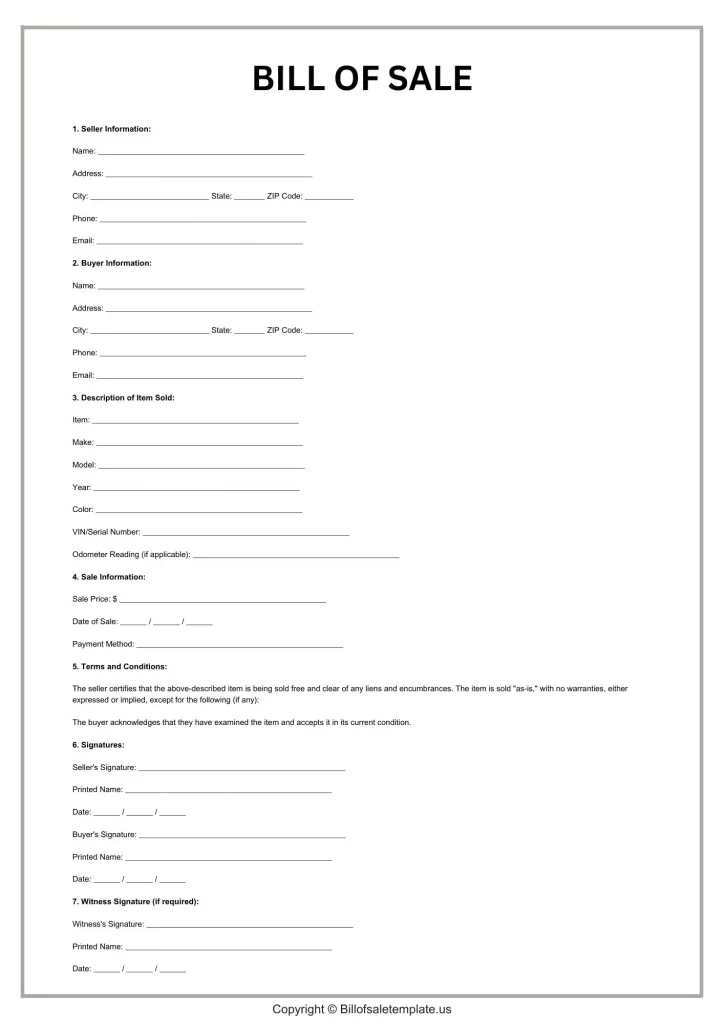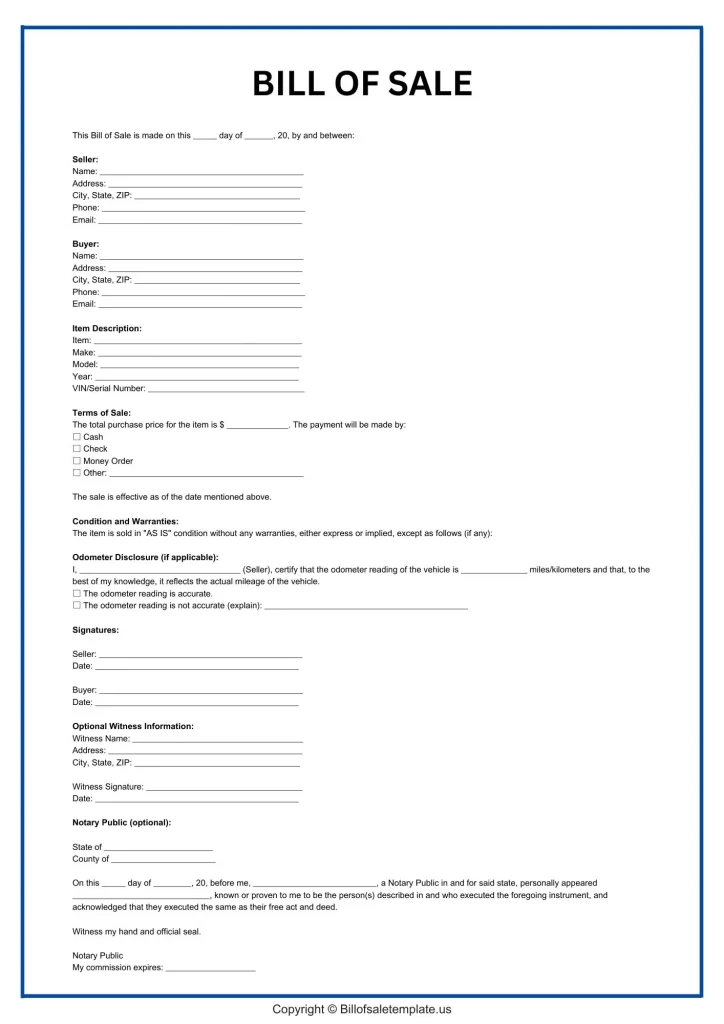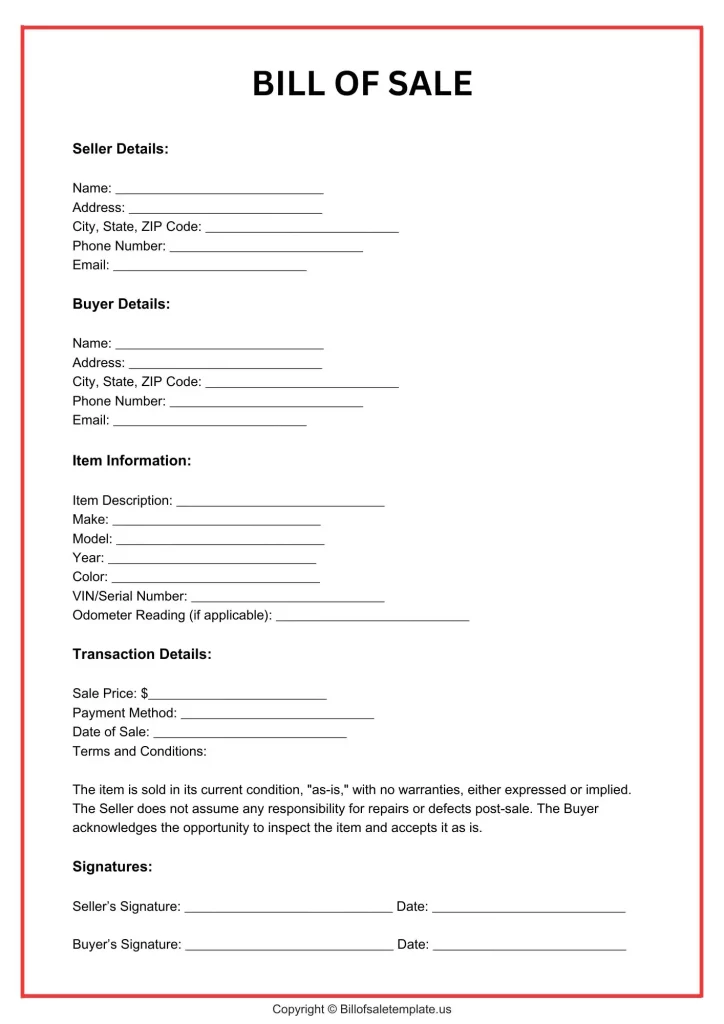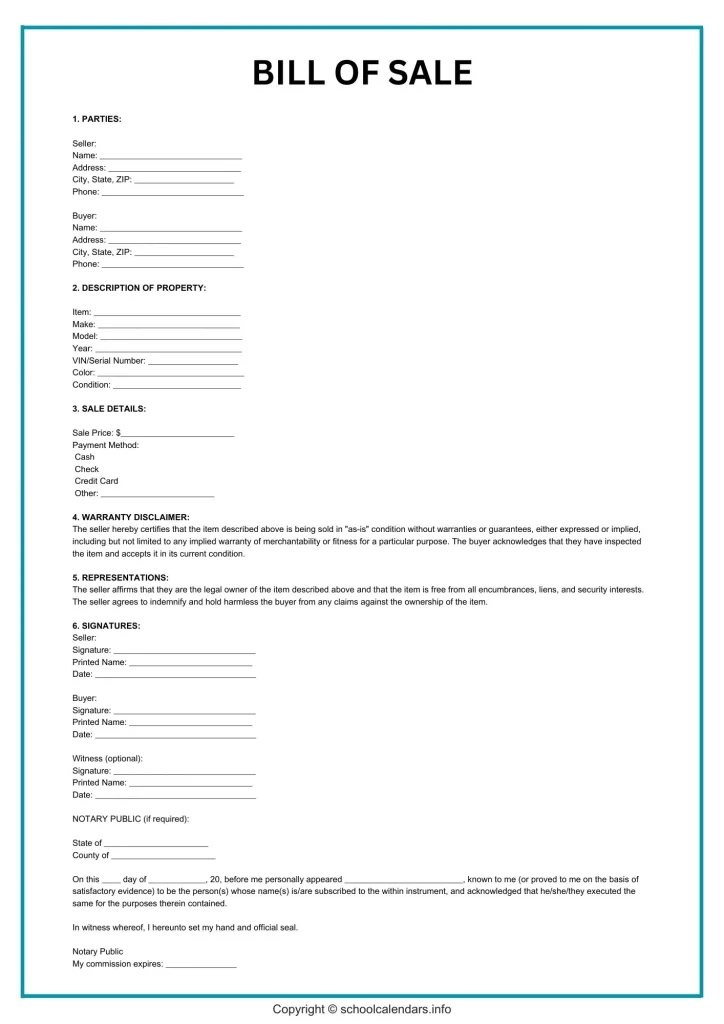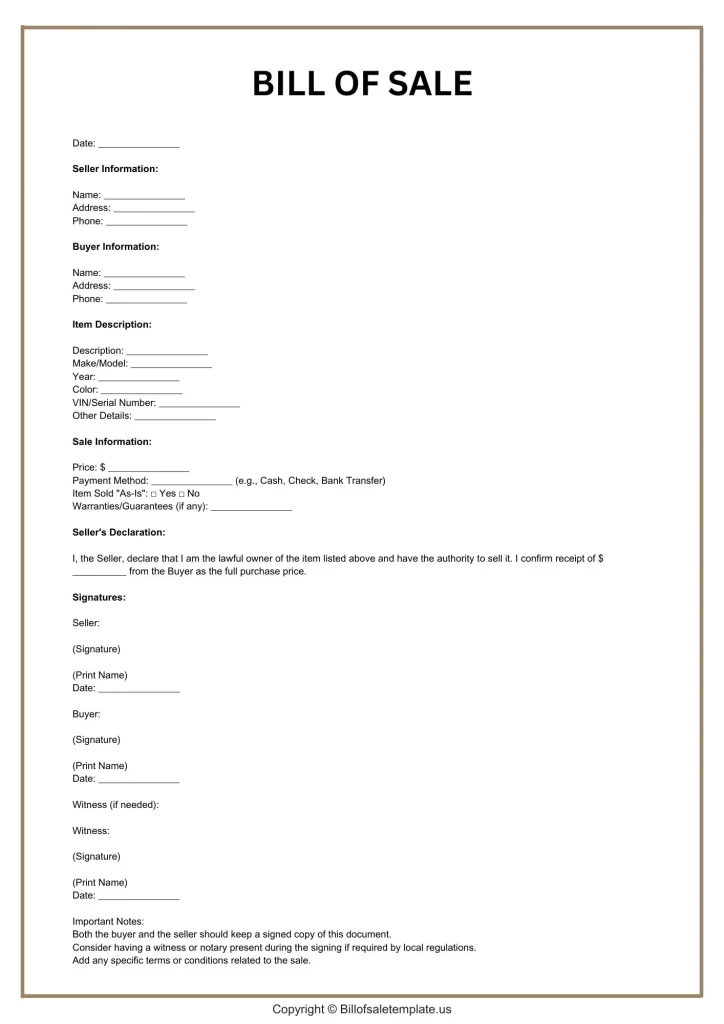Bill of Sales Template
A Bill of Sale is a legal document that serves as evidence of the transfer of ownership of an item from one party to another. It typically includes details such as the names and addresses of the buyer and seller, a description of the item being sold, the purchase price, and the date of the transaction.
Free Printable Bill of Sale Form Template ❤️
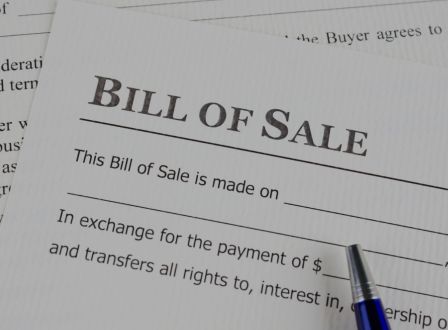
A Bill of Sale is a legal document that serves as evidence of the transfer of ownership of an item from one party to another. It typically includes details such as the names and addresses of the buyer and seller, a description of the item being sold, the purchase price, and the date of the transaction.
This document is commonly used for the sale of vehicles, boats, furniture, equipment, and other valuable items. This provides protection for both the buyer and the seller by documenting the terms of the sale and ensuring clarity regarding the transfer of ownership. Additionally, it can be crucial for establishing ownership in case of disputes or legal issues arising after the sale. While it is not always legally required for every transaction, it is highly recommended to create one to protect the interests of all parties involved.
Free Printable Bill of Sale Form Template
Here are the two main types:
Absolute Bill of Sale: This is the most common type of Bill of Sale Form. It transfers complete ownership of the item from the seller to the buyer with no conditions. In essence, it’s a receipt that proves the buyer now owns the item after a full purchase.
Conditional Bill of Sale: This type of bill of sale is used when the seller retains ownership of the item until certain conditions are met, typically full payment. This is common for big-ticket items like cars or furniture bought on credit. Once the buyer fulfills the conditions, the ownership is transferred completely.
Bill of Sale State Wise
How to write a Bill of Sale
Writing a Bill of Sale involves several steps to ensure it accurately reflects the details of the transaction and complies with legal requirements. Here’s a step-by-step guide:
- Identify the Parties Involved: Start by clearly identifying the buyer and seller. Include their full legal names, addresses, and any other relevant contact information. Make sure to verify the accuracy of this information.
- Describe the Item Being Sold: Provide a detailed description of the item being sold. Include information such as the make, model, year, serial number (if applicable), color, size, and any other distinguishing features. Be as specific as possible to avoid confusion.
- State the Terms of the Sale: Specify the terms and conditions of the sale. This should include the purchase price agreed upon by both parties, the method of payment (e.g., cash, check, installment payments), and any other relevant terms such as warranties or guarantees.
- Include the Date of the Sale: Clearly state the date when the transaction is taking place. This helps establish the timeline of the sale and is important for legal purposes.
- Signatures of Both Parties: Provide space for the signatures of both the buyer and the seller. Make sure each party signs the document in the presence of a witness or notary public if required by law. The signatures indicate that both parties agree to the terms outlined in the Bill of Sale.
- Witness or Notary Public Signature: Depending on local regulations and the nature of the transaction, it may be necessary to have a witness or a notary public sign the Bill of Sale to validate the document. Check the legal requirements in your jurisdiction.
- Optional: Add Additional Clauses: Depending on the nature of the transaction, you may want to include additional clauses to address specific concerns or contingencies. Common examples include clauses regarding the condition of the item, any liens or encumbrances, or a statement of “as-is” condition.
- Make Copies: After the Bill of Sale is signed by both parties and any necessary witnesses or notaries, make copies for each party to keep for their records. It’s essential to retain a copy for your own records as proof of the transaction.
- File as Necessary: Depending on local regulations, you may need to file the Bill of Sale with relevant authorities, such as the Department of Motor Vehicles for vehicle sales. Make sure to follow any specific filing requirements in your area.
By following these steps, you can create a comprehensive and legally sound Bill of Sale that protects the interests of both the buyer and the seller.
Keypoints of Bill of Sale Form Template
he key points include:
- Identification of Parties: Clearly identify both the buyer and the seller, including their full legal names and contact information.
- Description of Item: Provide a detailed description of the item being sold, including any relevant identification numbers or features.
- Purchase Price: Specify the agreed-upon purchase price for the item.
- Date of Sale: Clearly state the date when the transaction is taking place.
- Signatures: Both the buyer and the seller should sign the document to indicate their agreement to the terms of the sale.
- Additional Terms and Conditions: Depending on the nature of the transaction, include any additional terms and conditions agreed upon by both parties, such as warranties, guarantees, or “as-is” clauses.
- Witness or Notary Signature: Depending on local regulations and the nature of the transaction, it may be necessary to have a witness or a notary public sign the document to validate it.
Including these key points helps ensure that the BOS accurately reflects the terms of the transaction and protects the interests of both parties involved.
Bill of Sale Example For
Simple Bill of Sale
Seller Information:
Name: [Seller’s Name]
Address: [Seller’s Address]
City, State, ZIP: [City, State, ZIP Code]
Phone Number: [Seller’s Phone Number]
Buyer Information:
Name: [Buyer’s Name]
Address: [Buyer’s Address]
City, State, ZIP: [City, State, ZIP Code]
Phone Number: [Buyer’s Phone Number]
Description of Item Sold:
Make: [Make of Item]
Model: [Model of Item]
Year: [Year of Item]
Color: [Color of Item]
Serial Number: [Serial Number of Item, if applicable]
Purchase Price:
Total Purchase Price: $[Purchase Price]
Date of Sale:
Date: [Date of Sale]
I, [Seller’s Name], hereby sell the above-described item to [Buyer’s Name] for the total purchase price of $[Purchase Price]. I certify that I am the legal owner of the item and have the authority to sell it.
Seller’s Signature: _______________________ Date: _________
I, [Buyer’s Name], acknowledge receipt of the above-described item and agree to the terms of this sale.
Buyer’s Signature: _______________________ Date: _________
Witness (if required): _______________________ Date: _________
Handwritten Bill of Sale
Here are the two main types:
Absolute Bill of Sale: This is the most common type of Bill of Sale Form. It transfers complete ownership of the item from the seller to the buyer with no conditions. In essence, it’s a receipt that proves the buyer now owns the item after a full purchase.
Conditional Bill of Sale: This type of bill of sale is used when the seller retains ownership of the item until certain conditions are met, typically full payment. This is common for big-ticket items like cars or furniture bought on credit. Once the buyer fulfills the conditions, the ownership is transferred completely.
Keypoints of Bill of Sale Form Template
A handwritten bill of sale can be just as important as a typed one, but there are some key things to consider:
Validity:
-
Legally Binding: In most cases, is considered legally binding as long as it includes all the necessary information (discussed below). It acts as a contract between buyer and seller.
-
Strength in Court: While valid, a well-formatted typed document might hold more weight in court due to clarity and reduced chance of errors. A handwritten BOS could be challenged if handwriting is messy or details are unclear.
Importance:
-
Proof of Ownership: A bill of sale, whether typed or handwritten, provides crucial proof that the buyer now owns the item. This is especially important for private sales where there’s no official record of the transaction.
-
Dispute Resolution: If a disagreement arises about the sale (e.g., condition of the item, terms of the agreement), a clear BOS can help settle the dispute.
Best Practices for Handwritten Bills of Sale:
- Clarity is Key: Use neat and legible handwriting.
- Include Essentials: Seller and buyer names, item description (including serial numbers for valuables), sale price, date, and any warranties or “as-is” conditions.
- Signatures: Both buyer and seller should sign and date the document. Witnesses can add further weight (optional).
Alternatives to Consider:
- Typed Bill of Sale: If you have access to a printer, using a template for a typed bill of sale might be a better option for clarity and professionalism. Many free templates are available online.
A handwritten BOS can be an effective way to document the transfer of ownership, especially for private sales. However, for high-value items or situations where clarity is crucial, a typed document might be preferable. The most important thing is to have a clear and well-documented record of the transaction to protect both the buyer and seller.
FAQ
A BOS typically looks like a formal document containing details of a transaction between a buyer and a seller. It includes information such as the identities and contact details of both parties, a description of the item being sold, the purchase price, the date of the sale, and signatures of both parties. The document may also include additional clauses or terms specific to the transaction. It’s generally formatted to be clear and easy to read, often resembling a contract, and can vary in appearance depending on the preferences of the parties involved and any legal requirements in the jurisdiction.
A BOS is a legal document that acts as a receipt for transferring ownership of property from a seller to a buyer. Think of it as written proof that the buyer now owns the item they purchased. It’s commonly used for things like cars, furniture, or even animals, especially when buying from a private seller. This document helps protect both the buyer and seller in case of any disagreements in the future.
A Bill of Sale should include essential details such as the identities and contact information of both the buyer and seller, a description of the item being sold (including any relevant identification numbers or features), the purchase price, the date of the sale, and signatures of both parties. Additionally, it may include terms and conditions of the sale, any warranties or guarantees, and clauses addressing the condition of the item or any liens or encumbrances. While the exact content can vary depending on the nature of the transaction and local regulations, including these key elements helps ensure clarity and legal validity.
A bill of sale should clearly state the following: who the seller and buyer are, what item is being sold with a detailed description, the agreed-upon price, and the date of sale. It can also mention if the sale is “as-is” or includes any warranties. Having both parties sign the document creates a record of the transaction for future reference.
The “seller registration number” on a BOS is likely for a dealer or reseller and not typically needed for private sellers. If you’re selling privately, just leave that section blank.
Ideally, both the buyer and seller should keep a copy of the bill of sale. The buyer typically gets the original for their records, and the seller keeps a copy for themselves. This way, both parties have proof of the transaction in case of future issues.
A bill of sale can be notarized by a notary public. They are government-authorized officials who verify the identities of the people signing the document and ensure the entire process is legitimate.
Ideally, both the buyer and seller keep a copy of the bill of sale. The buyer typically gets the original for their records, while the seller keeps a copy for theirs.
In most cases, both the seller and buyer need to sign a BOS. This ensures both parties have a record of the agreement.
A document qualifies as a BOS if it:
- Records the transfer of ownership of personal property (not real estate) from seller to buyer.
- Includes key details like seller/buyer names, item description, price, and date.
To get a title with a BOS, you typically need to follow these steps:
- Obtain a completed Bill of Sale from the seller, including all necessary details such as the description of the item, purchase price, and signatures of both parties.
- Check with your local Department of Motor Vehicles (DMV) or relevant authority to determine their specific requirements for transferring ownership using a BOS.
- Complete any additional paperwork or forms required by the DMV, which may include an application for a new title or a transfer of ownership form.
- Submit the completed paperwork, along with the BOS and any required fees, to the DMV or relevant authority.
- Wait for processing, which may take several days to weeks depending on your location and the workload of the DMV.
- Once approved, you should receive a new title in your name, indicating that you are the legal owner of the item.
It’s essential to ensure that the Bill of Sale is properly completed and includes all necessary information to facilitate the title transfer process smoothly.
A notarized Bill of Sale means that the document has been signed in the presence of a notary public, who verifies the identities of the parties involved and ensures that the signatures are authentic. The notary public then affixes their official seal and signature to the document, indicating that the signing process has been properly witnessed and that the parties entered into the agreement willingly and knowingly.
Key Points of a Notarized Bill of Sale:
- Verification of Identity: The notary public checks the identification of the buyer and seller to ensure they are who they claim to be.
- Witnessing the Signing: The notary public observes the signing of the Bill of Sale, ensuring that it is done voluntarily and without coercion.
- Official Seal and Signature: The notary affixes their official seal or stamp and signs the document, providing an additional layer of authenticity.
- Legal Protection: A notarized Bill of Sale can provide stronger legal protection in case of disputes, as it serves as verified proof of the transaction.
Benefits of a Notarized Bill of Sale:
- Enhanced Credibility: The notarization process adds credibility and authenticity to the document.
- Dispute Resolution: It provides a reliable piece of evidence in the event of legal disputes regarding the sale.
- Compliance with Legal Requirements: In some jurisdictions or for certain types of transactions (like vehicle sales), notarization might be required by law.
Typical Process to Notarize a Bill of Sale:
- Prepare the Bill of Sale: Complete the document with all necessary details.
- Find a Notary Public: Locate a notary at a bank, law office, or via mobile notary services.
- Provide Identification: Present valid ID to the notary.
- Sign in the Presence of the Notary: Both parties sign the document in front of the notary.
- Notary Seals the Document: The notary affixes their seal and signs the document.
By following these steps, the Bill of Sale is properly notarized, ensuring it meets legal standards and provides protection for both the buyer and seller.
About Me

Ted Cruz is the founder and driving force behind BillofSaleTemplate.us, a comprehensive resource for free bill of sale templates tailored to meet a variety of needs. With a keen understanding of the importance of accurate and legally sound documentation, Ted has dedicated his expertise to providing accessible and user-friendly templates for all types of transactions, from vehicle sales to personal property exchanges.
Recognizing the diverse legal requirements across different states, Ted has meticulously crafted state-specific bill of sale templates to ensure compliance and ease of use for users nationwide. His commitment to simplifying the process of creating reliable and legally binding documents has made BillofSaleTemplate.us a trusted platform for individuals and businesses alike.
![Free Bill of Sale Template PDF, Word [United States]](https://billofsaletemplate.us/wordpress/wp-content/uploads/2024/06/bill-of-sale-Logo-1-189x74.png)
